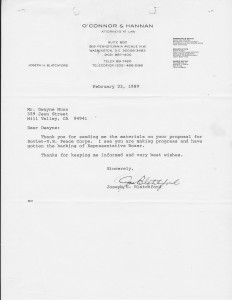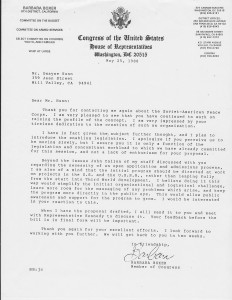Marin Independent Journal March 26, 1989
By Dwayne Hunn
MARIN VOICE
Dwayne Hunn is assistant executive director of Novato Ecumenical Housing and co-director of the North Bay Transportation Management Association
Opponents of the Hamilton project have used their interpretation of Novato’s redevelopment agency financing to lure supporters to their camp. They would benefit by contemplating Arthur Vandenberg’s wise words from the past.
It is less important to redistribute wealth than it is to redistribute opportunity. If the Hamilton project is rejected by the voters in June, the costs of doing business as usual will continue, forcing long Sonoma commutes that gridlock Highway 101, depriving the region of increasing and balancing the supply of jobs with affordable housing, and weakening the possibilities of making the train economically viable on the Northwestern Pacific right of way.
Rejecting the Hamilton project will force us to find more expensive means “to redistribute wealth to regain those lost opportunities in the future.” From this perspective I address some of the issues raised by the opponents.
The 400-plus acres purchased by Berg and Revoir for $45 million will be a master planned community. Opponents compare Hamilton to non-master planned communities where haphazard, piecemeal development at higher densities has occurred.
The Hamilton project calls for 215 acres to have 2,550 housing units, about 12 units per acre. Seventy acres have been set aside for parks, open space, lighted ball fields and so on. Woven throughout the project are bike and walking-running paths.
Hamilton Field’s boarded-up barracks, unused and rundown hangars and decaying underground utilities make it a blighted, stagnant area. Hamilton generates no tax revenue to the city of Novato, which has the lowest tax revenue per person of any city in the nine Bay Area counties.
In 1985 the use of redevelopment agency bond financing was an option available to the purchaser. Then, the cost estimates to improve the freeway and frontage road and to add interchanges (which until the Hamilton project have never been required of a private developer) were S7 million. In 1988, those cost estimates are $24 million.
The costs to totally replace sewers, electrical and water utilities, drainage and flood control improvements —which benefit the extended region in which Hamilton lies, including the Lanham Village, the mobile home park and the Hamilton School — also increased.
When these escalating redevelopment costs were added to the $33 million of Berg-Revoir site improvement costs, financial logic dictated that available redevelopment agency bond financing be requested.
Opponents claim that using redevelopment financing will steal Novato taxpayers’ dollars. The law says:
“Blighted areas are an economic and social drag upon the community and it is good public business to eliminate them. By the adoption of this constitutional amendment, it will be made possible for the property to pay its own way and ifnance the cost of redevelopment without any additional levy upon the already overburdened taxpayers.”
Project opponents claim there is same deep, dark conspiracy involved in redevelopment funding. Those weak sisters whom opponents must believe were blindfolded and arm-twisted into giving support include the Novato city staff, the Novato Unified School District, the sanitary district, the fire district and the police department, as well as every member of the Mann County Board of Supervisors.
After every new Hamilton-generated city service— every police, fire, school, park and road expense— is paid for, the city will annually receive about $165,000 in general revenues for about 30 years while the redevelopment agency bonds are paid off. After that, the city will receive between $2 million and $2.5 million per year. In addition, the city’s sales-tax revenues will jump by about $500,000 a year.
Perhaps most importantly, redevelopment agency financing will generate $32 million (non-inflated) or $92 million (inflated) to assist on-site workers in owning or renting at Hamilton. This assistance, mandated by the Community Redevelopment Act, along with the development and use of the adjacent railroad lines, is a strength that wasn’t even considered in the environmental impact report, which estimated the amount of traffic Hamilton could generate or the number of workers who could live on site.
In one fell swoop of about 10 years, Hamilton does more than 100 smaller projects to balance jobs and housing, to increase Novato revenues, to encourage the first of many needed pedestrian pockets which will promote transit use and traffic reduction, and to increase the supply of affordable housing.
Why is it that so many of the traditional naysayers want to push those opportunities off onto future generations where the cost will be much higher?


